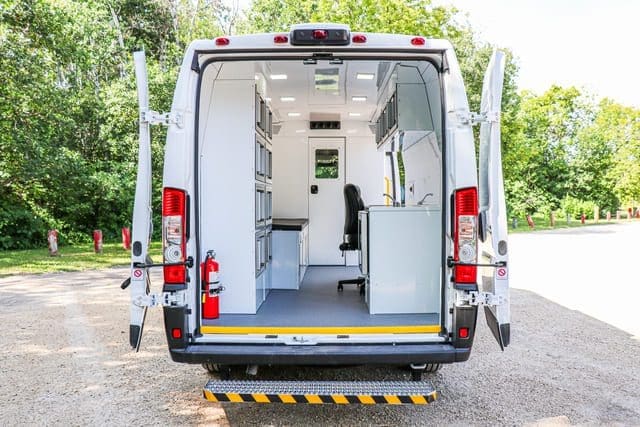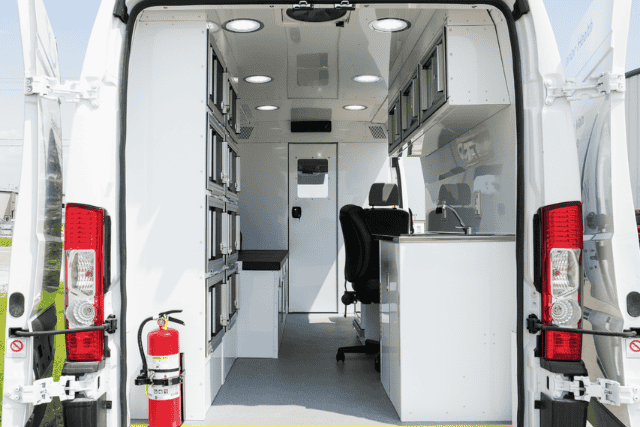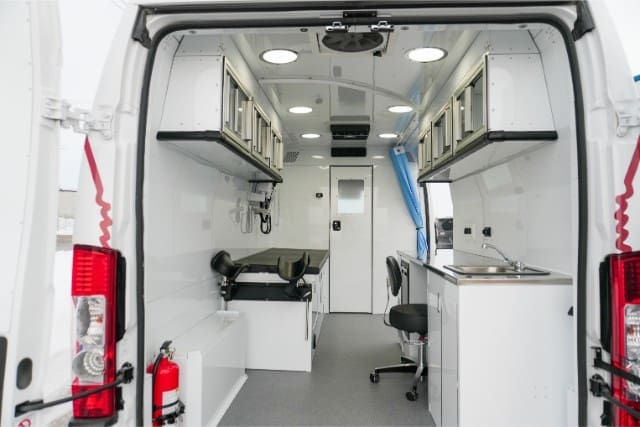As your organization draws closer to finalizing the decision of what mobile medical van to purchase, you need to think if you’re going with the Ram ProMaster vs. Ford Transit. Each option comes with its advantages and disadvantages. If you don’t carefully weigh each option, you risk ending up with a vehicle that doesn’t fulfill your organization’s goals effectively.
At AVAN Mobility, we’ve been building 5 types of mobile medical vans on the Ram ProMaster 2500 159″ Wheelbase High Roof model for years. We’ve enabled hundreds of organizations to help their patients overcome healthcare barriers across the nation with these vans.
If your organization is feeling a bit confused about which option to consider, why not reach out to one of our commercial mobility experts? Or, you can continue reading to learn about the pros and cons of the Ram ProMaster vs. Ford Transit mobile medical vans.
What is the Ram ProMaster?
The Ram ProMaster is a spacious, strong, and durable van that’s great for many jobs, including converting it into a traveling doctor’s office. It joined the Ram family in 2013 and quickly became popular for its ability to do a lot of different things well.
Because of its size, it’s really good for organizations that need to move a lot of things or set up shop on the go. That’s what makes it such an ideal option for turning into a mobile medical unit. In addition, your organization can change it around to fit what it needs. This is why organizations who need a moving health clinic love it.
The ProMaster was originally based on a van from Europe called the Fiat Ducato, which has been a top seller there for over 30 years. This means the ProMaster is not only tough like we expect in America but also smart and efficient like European designs. It’s a great choice for anyone who needs to take a lot of gear on the road.
Pros of the Ram ProMaster
Easy transformation: The Ram ProMaster’s square and boxy shape makes it simpler and quicker to turn into a mobile medical unit compared to the Ford Transit. The faster conversion allows your team to get on the road and start helping communities sooner. Take a quick look at the Mobile Clinic Van to see an example of what the Ram ProMaster can be converted to.
Extra length: With a 159″ wheelbase, the Ram ProMaster is around one foot longer than the Ford Transit’s 148-inch wheelbase. This added length gives more space inside the van, letting you arrange medical equipment better and create a comfortable space for patients.
Wide interior: The ProMaster has the widest interior among its competitors. This extra width provides a spacious area to work inside the van, making it easier for healthcare professionals to organize and deliver their services to patients effectively.
Economic efficiency: The ProMaster is made to be affordable to own. It has a high roof option so you can fit more things inside without using up a lot of gas. It’s also built to last a long time, and you can easily find parts for it. This means you won’t have to spend a lot of money to keep it running. This makes the ProMaster a smart pick for organizations that have strict budgets.
Durability: The ProMaster is quite durable. If you maintain them, they usually last between 250,000 to 300,000 miles. While it might not go as far as some Transits, it still stays strong for a long time, making it a reliable choice for its cost.
Cons of the Ram ProMaster
Style: The boxier style of the Ram ProMaster might not be everyone’s cup of tea. While its boxier design might afford you a bit more room, it might not match your tastes.
Resale value: Over time, ProMasters have tended to have a bit lower resale values compared to the Ford Transit.
Engine options: Unlike the Ford Transit, which offers a range of engine choices, the ProMaster limits you to just one.
What is the Ford Transit?
Now, let’s talk about the Ford Transit. The Ford Transit hit the North American roads in 2015. It quickly earned its stripes as a top choice for many, including those looking to bring healthcare services to communities and neighborhoods. What stands out about the Transit is its incredible versatility and reliability.
Ford designed the Transit with different sizes and shapes in mind. That means it can be just the right fit for any job. If you’re delivering healthcare to remote communities or holding vaccine clinics, the Transit molds to your mission. Its adaptability even offers various roof heights and lengths to ensure that your organization’s specific needs are met.
Just like its competitor, the Ford Transit can be customized inside to create the perfect mobile clinic van. It’s all about making healthcare accessible to everyone, anywhere. The Ford Transit stands as a vehicle of reliability, ready to serve and support communities with every mile it travels.
Pros of the Ford Transit
Longevity: When you take good care of them, Ford Transit vans can last a really long time. Many of them go beyond 300,000 miles and some even pass the 400,000-mile mark.
Customizable options: The Ford Transit is typically customized with the medium roof height and long wheelbase chassis. It offers a lot of customization to fit specific operational needs, from mobile clinics to accessible transport services. This variety ensures that every organization can find a Transit model that perfectly fits their requirements.
Engine Performance: The Transit can be equipped with multiple engine options, including a 3.5-liter EcoBoost® V6 that delivers up to 310 horsepower and 400 lb-ft of torque. Its 2.0-liter EcoBlue® Turbo Diesel option is notable for efficiency, offering a balance of power and fuel economy.
Safety technology: The Transit leads with Ford Co-Pilot360™, a suite of advanced safety features including:
- Automatic emergency braking
- Lane-keeping system
- Adaptive cruise control
Comfort: The Transit’s design prioritizes driver comfort with an ergonomic cockpit, adjustable seating, and a smooth ride quality. /This helps to reduce driver fatigue on long trips. This focus on comfort is helpful for organizations that require their vehicles to be on the road for extended periods.
Cons of the Ford Transit
Conversions might take more time: The walls of the Ford Transit are a bit more curved than the Ram ProMaster. This means it might take a little more work and time to customize them.
Base price: Generally, the Ford Transit comes with a higher starting price than the Ram ProMaster. This initial cost difference can be a significant factor for organizations with tight budgets. It can also make it tough for those looking to maximize their investment in a fleet.
Maneuverability in tight spaces: The Transit’s larger dimensions, especially in its high-roof and extended-length versions, might pose challenges in maneuverability within urban environments or tight spaces. The Ram ProMaster, with its front-wheel-drive layout, offers a tighter turning radius that can be beneficial in such scenarios.
All-wheel drive availability: While the Ford Transit offers an all-wheel-drive (AWD) option, it’s not standard across all models. The Ram ProMaster’s front-wheel-drive system provides better traction in slippery conditions. For organizations that often operate in climates with poor weather conditions, the availability and additional cost of AWD in the Transit might be a drawback.
Your next steps with AVAN Mobility
You landed on this article while looking into the differences between the Ram ProMaster and the Ford Transit. We hope this information has given you some insight into which one to choose.
Our team at AVAN Mobility always wants you to make the right choice for your mobile medical unit needs. If you’re still confused about which option to consider, click the button after this article to talk to a commercial mobility expert. From here, we think you’ll benefit from reading our article on mobile medical van costs.
If you’re struggling with the costs, read our article on grants.





